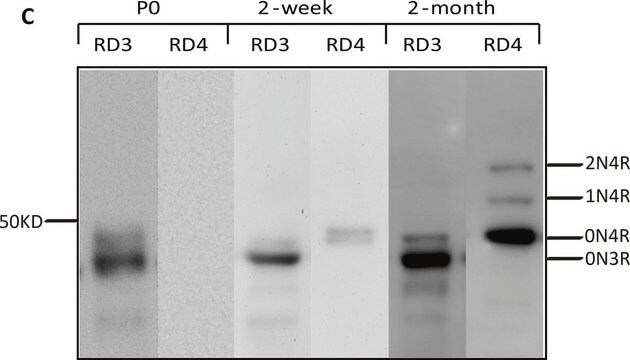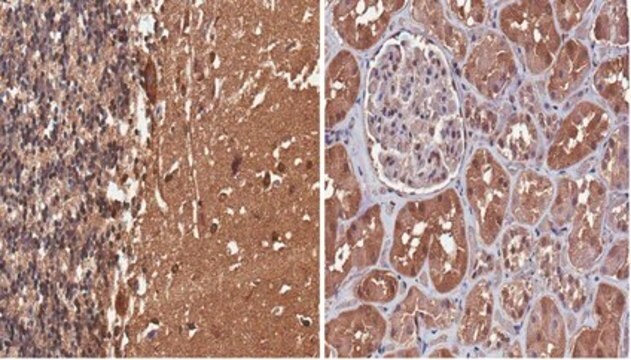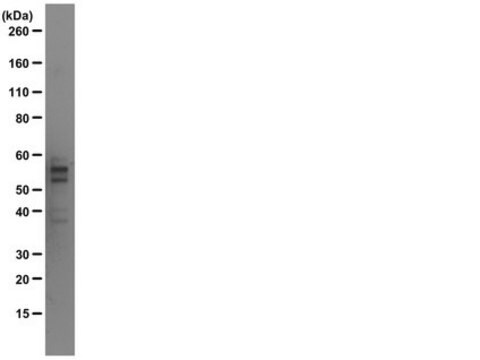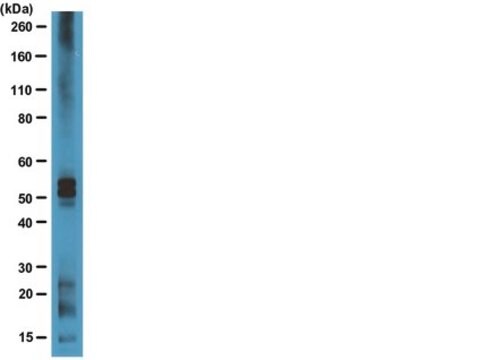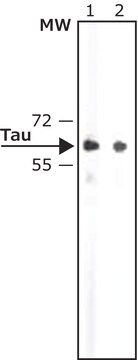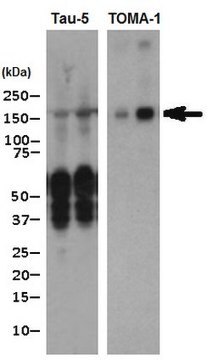おすすめの製品
由来生物
mouse
品質水準
抗体製品の状態
culture supernatant
抗体製品タイプ
primary antibodies
クローン
1E1/A6, monoclonal
化学種の反応性
mouse, bovine, human, rat
メーカー/製品名
Upstate®
テクニック
immunohistochemistry: suitable
western blot: suitable
アイソタイプ
IgG
NCBIアクセッション番号
UniProtアクセッション番号
輸送温度
wet ice
ターゲットの翻訳後修飾
unmodified
遺伝子情報
human ... MAPT(4137)
mouse ... Mapt(17762) , Mapt(281296)
rat ... Mapt(29477)
詳細
Microtubule Associated Proteins, or MAPS, bind to the tubulin subunits of microtubule structures and regulate their functional stability. In the cell MAPs bind to monomer and multimerized tubulin. MAP binding to multimerized tubulin further stabilizes the formation of higher order microtubulin structures. MAP binding to microtubule structures is mediated through phosporylation through Microtubule Affinity Regulated Kinase (MARK). Phosphorylation releases MAPs bound to microtubules, destabilizing the structure, driving it toward disassembly. There are predominately two MAP types, I, II. Type II MAP includes MAP2, MAP4, and tau and are found in nervous tissue. Six tau isoforms exist in brain tissue, and they are distinguished by their number of binding domains. Three isoforms have three binding domains and the other three have four binding domains. The binding domains are located in the carboxy-terminus of the protein and are positively-charged (allowing it to bind to the negatively-charged microtubule). The isoforms with four binding domains are better at stabilizing microtubules than those with three binding domains.
特異性
Cross-reactivity with mouse and bovine expected due to sequence homology.
Recognizes Tau (4-repeat isoform RD4), Mr 45-65 kDa. Higher MW band (68-72 kDa) represents phosphorylated Tau.
免疫原
Bovine thyroglobulin-conjugated synthetic peptide corresponding to amino acids 275-291 (VQIINKKLDLSNVQSKC) of human Tau (4-repeat isoform RD4). Region is flanking junction coded by adjacent exons 9 & 11 with the inclusion of exon 10. The immunizing sequence is identical in human, rat, mouse and bovine.
アプリケーション
Research Category
ニューロサイエンス
ニューロサイエンス
Research Sub Category
キナーゼ及びホスファターゼ
神経変性疾患
キナーゼ及びホスファターゼ
神経変性疾患
Immunohistochemistry:
This antibody has been reported by an independent laboratory to detect Tau (4-repeat isoform RD4) in autoclaved paraffin brain sections. (De Silva, R., 2003;Togo, T., 2002)
Differential Detection of Tauopathies: (Togo, T., 2002)
This antibody has been reported by an independent laboratory to detect Tau (4-repeat isoform RD4) in autoclaved paraffin brain sections. (De Silva, R., 2003;Togo, T., 2002)
Differential Detection of Tauopathies: (Togo, T., 2002)
This Anti-Tau (4-repeat isoform RD4) Antibody, clone 1E1/A6 is validated for use in IH, WB for the detection of Tau (4-repeat isoform RD4).
品質
Routinely evaluated by western blot on rat brain cytosol fraction.
Western Blot Analysis:
A 1:1,000-1:10,000 dilution of this lot detected Tau (4-repeat isoform RD4) in a rat brain cytosolic fraction.
Western Blot Analysis:
A 1:1,000-1:10,000 dilution of this lot detected Tau (4-repeat isoform RD4) in a rat brain cytosolic fraction.
ターゲットの説明
~68-72 kDa
物理的形状
Unpurified
Mouse monoclonal cultured supernatant containing 0.05% sodium azide.
Frozen at -20°C.
Frozen at -20°C.
保管および安定性
Stable for 1 year at -20°C from date of receipt.
Handling Recommendations: Upon first thaw, and prior to removing the cap, centrifuge the vial and gently mix the solution. Aliquot into microcentrifuge tubes and store at -20°C. Avoid repeated freeze/thaw cycles, which may damage IgG and affect product performance. Note: Variabillity in freezer temperatures below -20°C may cause glycerol containing solutions to become frozen during storage.
Handling Recommendations: Upon first thaw, and prior to removing the cap, centrifuge the vial and gently mix the solution. Aliquot into microcentrifuge tubes and store at -20°C. Avoid repeated freeze/thaw cycles, which may damage IgG and affect product performance. Note: Variabillity in freezer temperatures below -20°C may cause glycerol containing solutions to become frozen during storage.
アナリシスノート
Control
Rat brain cytosolic fraction.
Rat brain cytosolic fraction.
その他情報
Concentration: Please refer to the Certificate of Analysis for the lot-specific concentration.
法的情報
UPSTATE is a registered trademark of Merck KGaA, Darmstadt, Germany
免責事項
Unless otherwise stated in our catalog or other company documentation accompanying the product(s), our products are intended for research use only and are not to be used for any other purpose, which includes but is not limited to, unauthorized commercial uses, in vitro diagnostic uses, ex vivo or in vivo therapeutic uses or any type of consumption or application to humans or animals.
適切な製品が見つかりませんか。
製品選択ツール.をお試しください
保管分類コード
10 - Combustible liquids
WGK
WGK 2
適用法令
試験研究用途を考慮した関連法令を主に挙げております。化学物質以外については、一部の情報のみ提供しています。 製品を安全かつ合法的に使用することは、使用者の義務です。最新情報により修正される場合があります。WEBの反映には時間を要することがあるため、適宜SDSをご参照ください。
Jan Code
05-804:
試験成績書(COA)
製品のロット番号・バッチ番号を入力して、試験成績書(COA) を検索できます。ロット番号・バッチ番号は、製品ラベルに「Lot」または「Batch」に続いて記載されています。
Pathological inclusion bodies in tauopathies contain distinct complements of tau with three or four microtubule-binding repeat domains as demonstrated by new specific monoclonal antibodies.
de Silva, R, et al.
Neuropathology and Applied Neurobiology, 29, 288-302 (2003)
Parenchymal and vascular lesions in ageing equine brains: histological and immunohistochemical studies.
M T Capucchio,M Marquez,P Pregel,L Foradada,M Bravo,G Mattutino,C Torre,D Schiffer et al.
Journal of Comparative Pathology null
The complex relationship between soluble and insoluble tau in tauopathies revealed by efficient dephosphorylation and specific antibodies
Hanger, D P, et al
Febs Letters, 531, 538-542 (2002)
Differential involvement and heterogeneous phosphorylation of tau isoforms in progressive supranuclear palsy.
Gibb, G M, et al.
Brain Research Molecular Brain Research, 121, 95-101 (2004)
Dementia with Lewy bodies from the perspective of tauopathy.
Iseki, Eizo, et al.
Acta neuropathologica, 105, 265-270 (2003)
ライフサイエンス、有機合成、材料科学、クロマトグラフィー、分析など、あらゆる分野の研究に経験のあるメンバーがおります。.
製品に関するお問い合わせはこちら(テクニカルサービス)